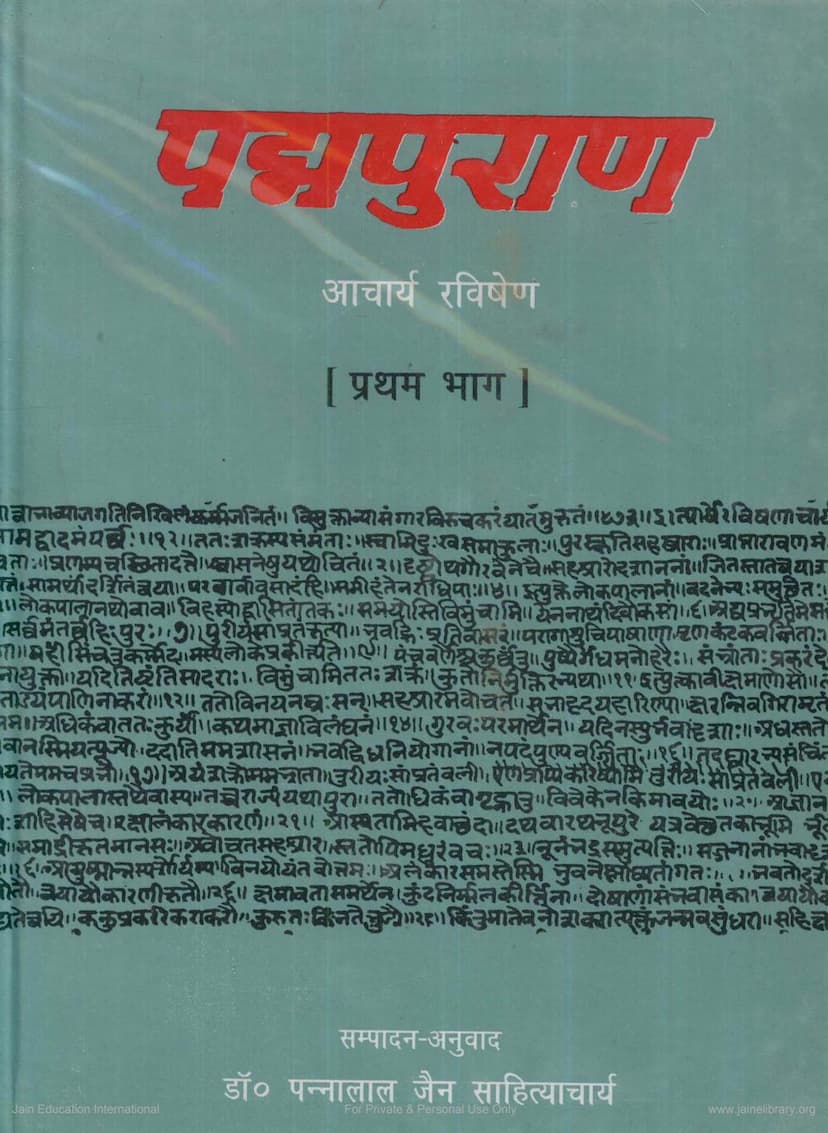Padmapuran Part 1
Added to library: September 2, 2025

Summary
This is a comprehensive summary of the provided Jain text, focusing on the content of "Padmapuran Part 1" by Ravishana Acharya, as gleaned from the introductory and excerpted pages.
Book Title: Padmapuran Part 1 (also referred to as Padmacharitam) Author: Ravishana Acharya (7th Century CE) Publisher: Bharatiya Gyanpith Catalog Link: https://jainqq.org/explore/001822/1
Overview:
The provided text is the first part of the Padmapuran, a significant Sanskrit Jain religious epic composed by Ravishana Acharya in the 7th century CE. It is considered a masterpiece of Jain narrative literature, celebrated for its poetic brilliance, psychological depth, and intricate character portrayals. The work chronicles the life of Rama, who is revered in Jain tradition as Padma, one of the 63 "Shalaka Purushas" (illustrious individuals). The text highlights the Jain perspective on the Ramayana narrative, often presenting a distinct theological and philosophical framework compared to other traditions.
Key Aspects and Themes:
-
Jain Tradition and Rama: In Jainism, Rama (Padma) is recognized as a Vashudeva (a powerful spiritual and temporal leader) and is counted among the 63 Shalaka Purushas. His life story, which is central to the epic, is presented with Jain principles and beliefs woven throughout.
-
Literary Excellence: Ravishana Acharya's Padmapuran is highly praised for its poetic artistry (kavya-lalithya). The text is described as a "Mandakini" (a celestial river) flowing from the "Mans-himakandara" (cave of the mind) of the poet, signifying its profound beauty and spiritual inspiration.
-
Character Portrayal and Psychoanalysis: The epic is lauded for its exceptional characterization and psychoanalytic insights. The author delves into the minds and motivations of the characters, creating vivid and complex personalities.
-
Inclusion of Diverse Narratives: While the main narrative revolves around Rama, the text also incorporates related stories and characters, such as the world of the Vidyadhara (celestial beings), the tales of Anjana and Pawananjay, Hanuman, and Sukosal. These elements enrich the narrative and enhance its appeal, making it difficult for readers to put down.
-
Relationship with Other Jain Ramayanas: The introduction notes that the Padmacarita (another name for the work) is one of the earliest Jain Puranas related to Rama's story, alongside Vimalasuri's Prakrit Paumacariyam and Swayambhu's Apabhramsha Paumacariu. It also mentions that the story is found in other major Jain works like the Sanskrit Mahapurana by Jinagana and Gunabhadra, Pushpadanta's Apabhramsha Mahapurana, and Hemachandra's Sanskrit Trishashthi Shalakapurusha Charita.
-
Theological and Doctrinal Differences: The introduction points out variations in the narrative compared to other traditions. For instance, in the second category of Jain Ramayanas (including Gunabhadra and Pushpadanta), Dasharatha is considered the king of Varanasi, and Sita is portrayed as the daughter of Ravana's queen, Mandodari. This divergence in origin stories is noted as a subject of academic interest.
-
Scholarly Editing and Translation: The Bharatiya Jnanpith edition, particularly the one edited and translated by Dr. Pannalal Jain Sahityacharya, is highlighted. This version includes a prologue, appendices, and a Hindi translation, published in three volumes, indicating its comprehensiveness and accessibility to a wider audience. The availability of this edition serves the needs of scholars, researchers, and avid readers.
-
Key Characters and Their Depiction:
- Rama (Padma): The central figure, depicted as a "Maryada Purushottam" (the ideal man who upholds boundaries and righteousness).
- Lakshmana: Rama's devoted brother, described as an embodiment of fraternal affection.
- Sita: Rama's wife, presented as the epitome of wifely devotion.
- Ravana: The antagonist, portrayed as a formidable Vidyadhara king, whose pride and actions lead to his downfall.
- Mandodari: Ravana's virtuous wife, who often tries to guide him towards righteousness.
- Dasharatha: Rama's father, characterized as an obedient son and a just king.
- Kaikayi: Dasharatha's queen, whose actions influence Rama's exile.
- Janaka: Sita's father, depicted as a wise and self-respecting king.
- Hanuman: Described as a Vidyadhara, with a detailed account of his birth and childhood exploits.
- Vibhishana: Ravana's righteous brother, who sides with Rama.
-
Narrative Structure and Content (as per the Table of Contents): The table of contents indicates the book progresses through various episodes, starting with the introduction of the lineage, moving through the lives of earlier Tirthankaras and Shalka Purushas, detailing the history of the Vidyadhara and Rakshasa clans, the monkey lineage, Ravana's rise and exploits, the birth and marriage of Rama and Sita, their exile, the search for Sita, the war, and finally, the events following the war.
-
Discussion on Jain Ramayana's Origins: The preface delves into the complex relationship between the Sanskrit Padmapuran and the Prakrit Paumacariyam. It discusses the debates surrounding their authorship dates and the possibility of translation, referencing scholars like Winternitz and Jacobi. It also highlights Nathuram Premi's arguments regarding the likely influence of Prakrit on Sanskrit, particularly concerning the term "Maahan" (Brahmin).
-
Sita's Birth Narratives: The preface also touches upon the various accounts of Sita's birth found in different traditions, including the Jain perspective, the Buddhist Dasaratha Jataka, and the Adbhut Ramayana.
In essence, Padmapuran Part 1 by Ravishana Acharya is a foundational text in Jain literature, offering a spiritually imbued and artistically refined retelling of the Ramayana, deeply rooted in Jain philosophy and ethics.